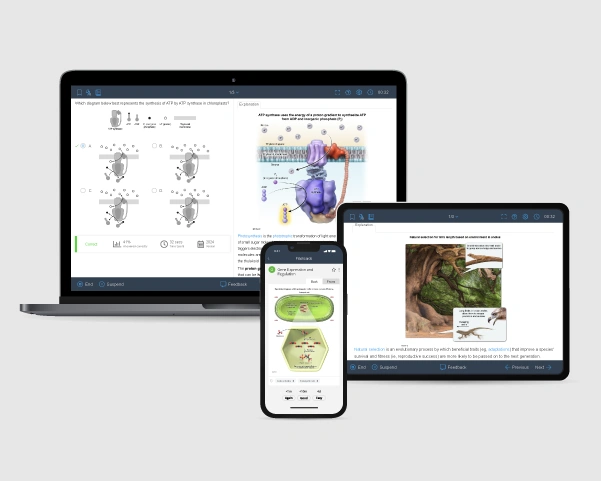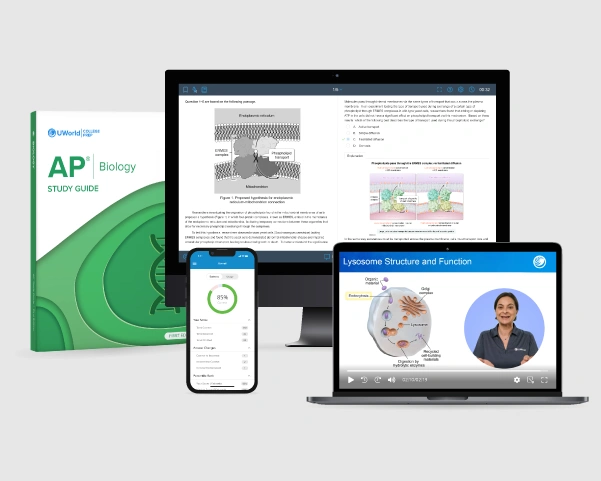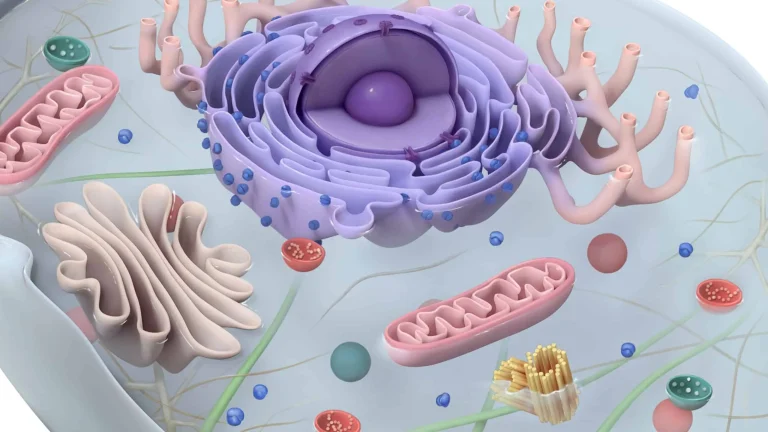In this article, we will discuss how to use key strategies, provide tips on how to tackle AP Biology free response questions, common task verbs used in the FRQs and what they mean, and an overview of each type of FRQ you will see on the AP Biology exam.
AP Biology FRQ Section Format and Scoring
The AP Bio FRQ section comprises 6 questions worth 50% of your final exam score. The first 2 questions will always be long and worth 8-10 points each. The other 4 are short and worth 4 points each.
As AP Biology is a hybrid exam, you’ll view free-response questions in the Bluebook testing app but handwrite your answers in paper exam booklets. FRQs are then scored by AP Readers (AP Biology teachers and college instructors) using specific scoring standards. Points are awarded when you meet specific criteria, so demonstrate your understanding clearly.
- Although your AP Reader is an expert, write as if explaining to someone unfamiliar with biology, defining scientific terms as needed.
- Organize your answer according to the question’s parts (a, b, c, d) to help the reader grade easily. Write legibly with a blue or black pen and only in the space provided. If you make a mistake, simply strike through it. Don't waste time trying to erase ink.
- Complete your thoughts fully. For example, if asked about diffusion, in addition to describing the process, explain that it stops at equilibrium, not just that molecules move from high to low concentration.
- Points are not deducted for incorrect answers, so attempt all questions. There are often multiple ways to earn points, and you will likely know something about each topic.
FRQ Types on the AP Biology Exam
Understanding the types of AP Bio FRQs will help you prepare thoroughly. Here’s a breakdown of each type:
FRQ 1: Working with experimental results
The first FRQ presents an experimental scenario with results in a graph or table. You will need to describe and/or explain related biological concepts, identify experimental procedures, analyze data, and justify predictions pertaining to the given information.
FRQ 2: Working with experimental results + graphing
The second FRQ is very similar to FRQ 1 but requires constructing a graph or chart from data provided in a table. Remember to label axes or column headings, include units, keep scale consistent, plot data accurately, and include error bars or confidence intervals.
FRQ 3: Lab investigation
This first short-answer question describes a lab investigation. Using this information, you will be expected to describe and/or explain related biological concepts, identify procedures used, and make/justify predictions about the investigation’s results.
FRQ 4: Concept analysis
In this FRQ, you will be given a biological concept with some disruption. Describe and explain the concept, predict cause(s) and/or effect(s) of the disruption, and justify your prediction(s).
FRQ 5: Model/visual representation analysis
In this FRQ, you will be given a description of a biological concept along with a visual image. Using this information, you will need to describe components of the image, explain relationships within the concept, and represent how the image relates to larger biological concepts.
FRQ 6: Data analysis
This FRQ provides data in a table, graph, text, or figure. Using the information, you will have to describe the data, evaluate a hypothesis, and explain how the data relates to larger biological concepts.
Want more guided explanations? Check out our AP Biology Study Guide for step-by-step solutions to FRQ-style questions, available in print and digital formats.
How to Answer AP Biology Free-Response Questions
Success in the AP Bio FRQ section requires both subject knowledge and strategic thinking. Here are some proven strategies to maximize your score:
Pay Attention to Bolded Words
The College Board® bolds certain words in FRQs to guide you. These words typically relate directly to scoring points, often being “task verbs” directing specific actions.
- Consider what is needed to accomplish each part of the question as you read.
- Before moving on to the next question, ensure you have not missed anything in the current question.

Budget Time Wisely
You have 90 minutes for the AP Bio FRQ section. Use the first 10 minutes for reading, leaving about 20 minutes for each long FRQ and 10 minutes for each short-answer FRQ. You can answer the questions in any order.
Start with questions you feel most comfortable with and can answer quickly for maximum points. Use the 10-minute reading period to strategize. If you get stuck, leave space and move on to the next question, returning to the unfinished ones if time allows. If you finish early, review your responses to ensure you have answered all parts and fulfilled all requirements.
Be Concise But Thorough
Earning full credit on each FRQ isn’t about writing more but ensuring everything you write addresses the question directly. Focus on demonstrating your understanding of the concept, not impressing with your vocabulary. Use complete sentences, not outlines or bullet points. Mentioning a term without showing understanding doesn’t earn points. Don’t restate the question; just answer it directly. Once you’ve answered the question, stop writing to avoid contradictions.
If asked for examples, provide only the requested number. Extra examples aren’t scored. If you can’t spell a word, try your best. Explain ideas clearly even if you can’t recall specific terms.
One of the best ways to improve your performance is by studying AP Bio practice FRQs from past exams and online resources. For a comprehensive preparation plan, our AP Biology Online Prep Course offers everything you need. Featuring engaging videos, expert-designed practice questions, and much more, this all-in-one prep course is your key to top scores.
Common Task Verbs and Their Meanings
Understanding task verbs used in AP Biology FRQs helps you earn maximum points. Here are common verbs and their meanings:
-
Calculate: Apply mathematical steps using basic algebra or formulas from the provided Equations and Formulas sheet. Show your work for extra points, and use a calculator for accuracy. Highlight your final answer by boxing it.
- Example: Using Figure 1, calculate the average rate of change in growth in the control group.
-
Construct: Create a visual representation, such as a diagram, model or graph. Consider if labels or titles are needed, as these often earn points.
- Example: Construct a diagram showing the steps of mitosis.
-
Describe: Provide information about a particular process, topic, or experiment. Include a concrete example to show understanding.
- Example: Describe the role of protons in the electron transport chain.
-
Determine: Decide or conclude after evaluating information. Provide reasoning or evidence for your determination.
- Example: Using the experimental data, determine if the results are statistically significant.
-
Draw: Similar to “construct,” draw a representation of a concept. Ensure it includes necessary labels, units, or titles.
- Example: Using the provided phylogenetic tree, draw a circle around each of the two groups that are least closely related to one another.
-
Evaluate: Judge or conclude the significance of a claim or information. Include reasoning for your conclusion.
- Example: Evaluate the scientist’s hypothesis about the keystone species in the community.
-
Explain: Provide information on why or how something happened. Use specific examples or data from the question to demonstrate understanding.
- Example: Explain the functions of apoptosis in multicellular organisms.
-
Identify: This task verb requires you to indicate or give information pertaining to a specific topic.
- Example: Identify the dependent variable in the experiment.
-
Justify: Provide evidence to show that a claim is true using data from the question. You may need to explain how your evidence supports, defends, or modifies the claim.
- Example: Justify the scientist’s claim about this cell signaling pathway in yeast.
-
Make a Claim: State a factual assertion based on information from the question and/or from your content knowledge. Your claim should reflect what you believe to be true given the available information.
- Example: Using the data in Table 1, make a claim about the permeability of the experimental membrane.
-
Predict: Provide a reasonable, educated guess about the cause(s) or effect(s) of a change to a system, often including reasoning or data analysis.
- Example: Predict the effect of antibiotic treatment on the retrovirus.
-
Represent: Use illustrations, symbols, tables, graphs, and/or words to describe a biological concept.
- Example: Using the provided figure, represent the active site of the enzyme by writing an “X” on the appropriate portion of the figure.
-
State the Hypothesis: Provide a prediction relating to a scientific question,or identify a hypothesis from the information given.
- Example: State the null hypothesis of the experiment.
-
Support: Explain why a line of evidence favors a particular claim, often referencing given data or experimental results.
- Example: Support the researcher’s claim about the effect of a mutation in the CFTR gene.
One of the best ways to improve your performance is by studying AP Biology FRQ examples from past exams. Reviewing sample responses can help you understand how points are awarded and what graders look for in high-scoring answers.

Frequently Asked Questions (FAQs)
How many FRQs are on the AP Biology exam?
How are AP Bio FRQs graded?
How long is the FRQ section of the AP Bio exam?
Where can I get FRQs from past AP Biology exams?
References
- (2024). Exam Format. AP Biology. AP Central Retrieved January 03, 2025 from
https://apcentral.collegeboard.org/courses/ap-biology/exam - (2023). SECTION II: Free Response. 2022-23 AP Exam Instructions. AP Central Retrieved January 03, 2025 from
https://apcentral.collegeboard.org/media/pdf/ap-biology-exam-instructions.pdf - (2024). Task Verbs. AP Biology Exam Tips. AP Central Retrieved January 03,
2025 from
https://apstudents.collegeboard.org/courses/ap-biology/exam-tips
Related Topics
Want to ace the multiple-choice section of the AP Biology exam? Our comprehensive guide is packed with effective strategies to handle every question type you’ll face.
How to Study for AP BiologyLooking to score a 5 on your AP Biology exam? Explore comprehensive study schedules, top resources, and expert tips to help you prepare and achieve your highest score!
AP Biology Course and Exam Description (CED)Explore our guide to the AP Biology curriculum for in-depth information on units, topics, and key concepts you’ll study in the course.
Best AP Biology Prep Course ReviewDiscover the best AP Biology prep courses available. Compare key features, pricings, reviews, and benefits to select the course that best fits your learning.
Best AP Biology Study Guide ComparisonKaplan vs. Barron's vs. Princeton Review vs. UWorld—compare strategies, features, and effectiveness to find the ultimate guide for AP Biology success.
How to Self-Study for AP BiologyLearn effective tips and strategies to self-study for the AP Biology exam. Build confidence, master core concepts, and achieve a high score independently too.



